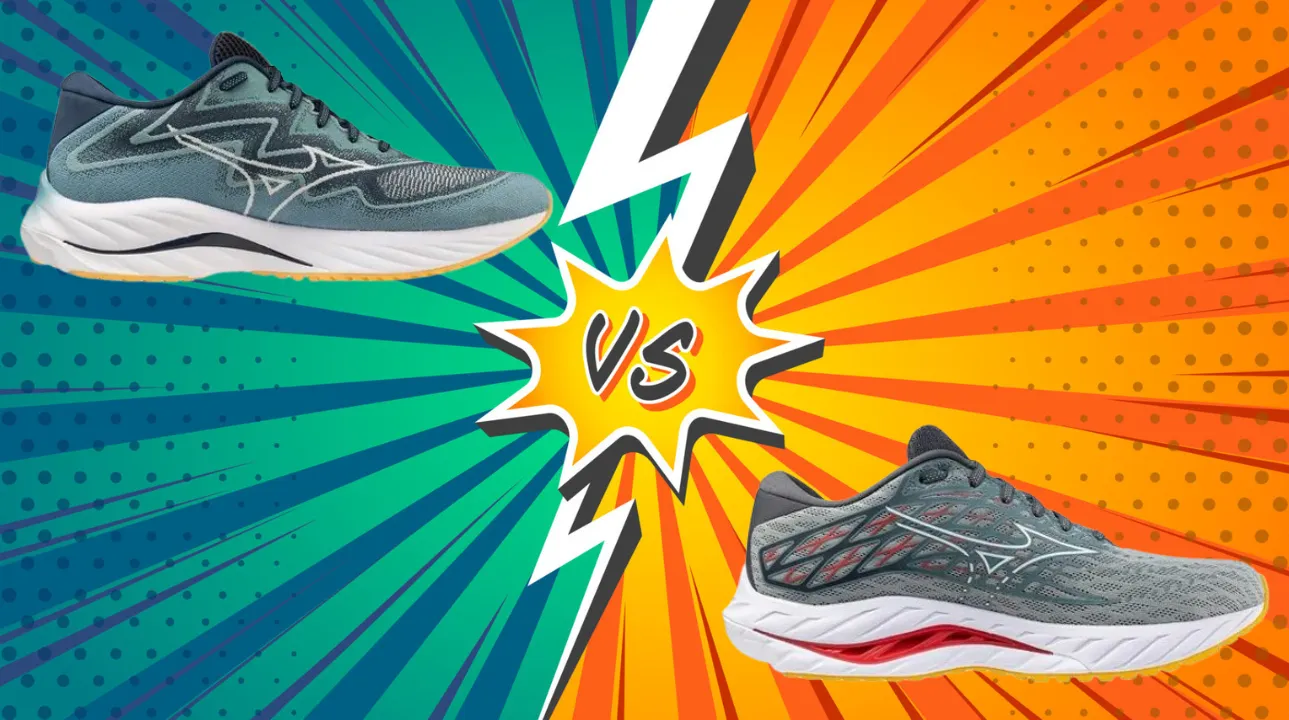The Mizuno Wave Rider and the Mizuno Wave Inspire are two of the most popular neutral and stability running shoes from Mizuno. The Wave Rider 27 and Wave Inspire 20 are the latest iterations of these two shoe lines.
Both shoes use Mizuno’s signature Wave plate technology in the midsole to provide a smooth and responsive ride. However, there are some key differences that cater each shoe to different types of runners and preferences.
This in-depth comparison examines the key specs, features, and performance of the Wave Rider 27 and Wave Inspire 20 to help you determine which model is the better option for your needs.
Comparison Table between Mizuno Wave Inspire 20 and Wave Rider 27:
| Feature | Wave Rider 27 | Wave Inspire 20 |
|---|---|---|
| Launched In | 2023 | 2024 |
| Stability | Neutral | Moderate Stability |
| Flexibility | Flexible | Less flexible |
| Sizing | True to size | Runs half size small |
| Weight | 9.9 oz | 10.7 oz |
| Cushion | Moderate | Balanced cushioning |
| Outsole | X10 carbon rubber | X10 carbon rubber |
| Midsole | U4icX | Enerzy foam |
| Upper | Engineered mesh | Engineered mesh |
| Retail Price | $140 | $140 |
Features Comparison:
Materials:
The Wave Rider 27 uses a full-length U4icX midsole which provides a good balance of cushioning and energetic rebound. The upper consists of a lightweight and breathable engineered mesh. The high-abrasion X10 carbon rubber outsole offers excellent grip and durability.
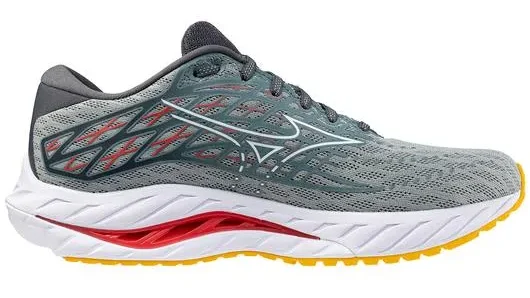
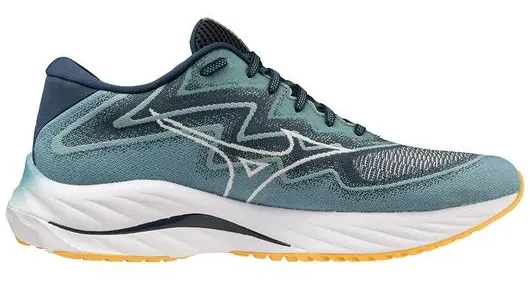
The Wave Inspire 20 features Mizuno’s Enerzy midsole foam which gives responsive cushioning. The upper is also an engineered mesh material for breathability. It shares the durable X10 carbon rubber outsole with the Wave Rider 27.
Durability:
Both the Wave Rider 27 and Wave Inspire 20 are durable shoes thanks to the X10 outsole. Testers found the Wave Inspire 20 to be slightly more durable, lasting over 500 miles. The Wave Rider 27 lasts for around 400-500 miles for most runners.
Fit:
The Wave Rider 27 fits true to size for most runners with a secure midfoot lockdown from the lacing system keeping it snug around the midfoot. The smooth and breathable upper material allows for flexibility around the forefoot without irritating rubbing or hot spots forming, even for medium to high mileage training.
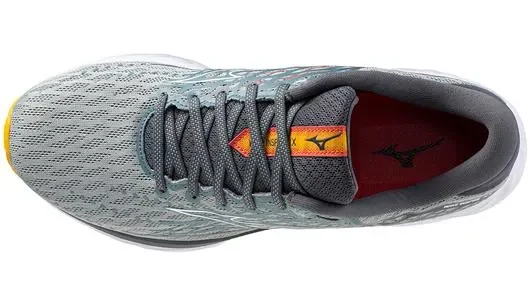
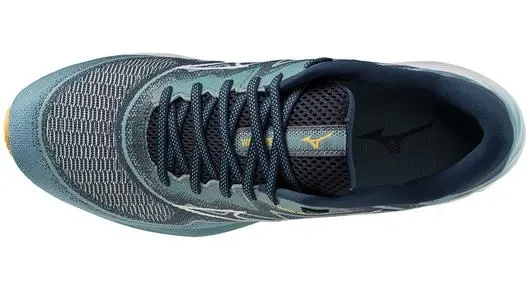
Meanwhile, the Wave Inspire 20 runs almost a half size too small according to some wearers, so sizing up is recommended. It also has a wide and spacious toe box area which is ideal for runners who need to accommodate orthotics or suffer from bunions.
Cushioning:
The Wave Rider 27 utilizes Mizuno’s U4icX midsole foam which delivers a firm yet energetic underfoot feel even during longer miles. Testers found it provides adequate shock absorption while still maintaining ground-feel and response for pushing faster paces. The curvature of the midsole also encourages a smooth heel-to-toe transition.
While the Wave Inspire 20 uses the more premium Enerzy midsole foam for plenty of softness without feeling too mushy or unstable underneath. It feels plush and protective during recovery days, long runs, and easy mileage helping to reduce fatigue and joint pounding.
Stability:
As a stability model, the Wave Inspire 20 better aids overpronators who need support integrating the SmoothRide Wave plate technology and a dual density midsole posting. However, the Wave Rider 27 still has mild stability characteristics with its Wave plate and well-balanced cushioning for more neutral runners.
The Inspire guides the foot well through each phase of the gait cycle while allowing just enough medial to lateral roll for a forgiving, training-friendly sensation. So severe overpronators will benefit most from its motion control.
Value:
With both the Wave Rider 27 and Wave Inspire 20 comes in at $140, you do get your money’s worth. However, the Wave Inspire 20 lasts slightly longer, providing about 100-150 more miles according to most runners. Since neutral runners can rotate shoes more frequently, the Wave Rider 27 still offers responsive cushioning and a fluid ride for $140.
But high mileage runners may stretch each dollar up to 8% further in the durable Inspire 20. At the end of the day, both are sound investments depending on if you prioritize responsiveness or maximum lifespan per dollar.
Performance comparison:
Walking:
Both the Wave Rider 27 and Inspire 20 are comfortable options for walking short distances thanks to the well-cushioned midsoles. The Inspire 20 provides slightly softer cushioning for longer walks such as hiking or all-day wear.
The smooth transition of the Rider 27 allows for a natural stride when walking faster paces. Those needing more support due to overpronation when walking will appreciate the stability features of the Inspire 20 guiding the foot properly.
Running:
For neutral runners looking for responsiveness and flexibility to pick up the pace, the Wave Rider 27 provides a smooth and seamless ride. The energetic foam and rockered geometry helps you transition quickly from landing to toe-off.
Meanwhile the Wave Inspire 20 offers more underfoot protection and stability for easy miles, long runs, and recovery days. Overpronators will also benefit from the dual density midsole correcting excessive rolling for injury prevention.
All-Day Standing:
Cushioning is vital for extended periods of standing and here the Wave Inspire 20 shines with its Enerzy foam lasting for hours without packing out. The soft foam keeps feet comfortable and supported in jobs that require long hours on your feet like retail or nursing. Ho
wever the Wave Rider 27 has enough cushion and shock absorption to provide adequate comfort for long shifts as well.
Plantar Fasciitis:
Since overpronation often aggravates plantar fasciitis, the stability provided by the Wave Inspire 20 can help prevent symptoms while running. It controls excessive arch or foot collapse.
Additionally, both shoes have moderate arch support and cushioned, yet responsive midsoles to distribute pressure away from the plantar fascia area. So those recovering from PF may find either option does not further aggravate irritation or inflammation.
Conclusion:
Overall, while both are high performing stability and neutral running shoes priced at $140, the Mizuno Wave Inspire 20 is the winner when comparing the two models.
The Wave Inspire 20 is longer lasting, providing an additional 100-150 miles of usage before needing replacement. This allows you to stretch each $140 spent up to 8% further over time. It also has better stability and support features specifically for overpronators who are injury prone. The plush Enerzy foam cushioning also makes the Inspire 20 more comfortable for walking, standing, and recovery days.
Neutral runners will still appreciate the smooth and lightweight performance of the Wave Rider 27 thanks to the responsive U4icX foam. But for most runners, the Inspire 20 combines the ideal blend of cushioning, support, lifespan and value at $140. Investing in the Inspire 20 gets you more mileage and usage for your money over time.

